Home > Nursery tree production > Root system > Propagating quality liners > Propagating trees: some latest research
Propagating trees: some latest research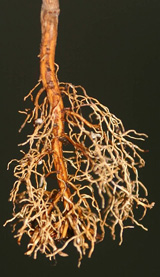
Trees with straight roots (right photo) are better quality than trees with many deflected roots. Roots that are straight can better secure themselves into substrate or soil. Straight roots have wood grain oriented in the direction of stress when a tree moves in the wind which makes them strong.
Roots deflected by container walls grow up, down or around the container wall (photo below). They are twisted when stressed by wind action which makes them weak. Roots deflected by container walls also 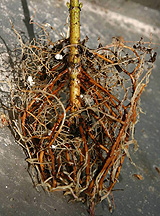 grow around the trunk which can result in parts of the trunk being strangled (photo center right). This restricts movement of water and elements up the trunk and can result in part of the tree dying back. Sometimes the entire tree dies; sometimes the tree grows through this and appears to be fine.
grow around the trunk which can result in parts of the trunk being strangled (photo center right). This restricts movement of water and elements up the trunk and can result in part of the tree dying back. Sometimes the entire tree dies; sometimes the tree grows through this and appears to be fine.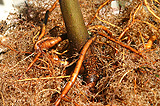
Small propagation containers which air-prune or are coated with copper hydroxide promote branching of roots rather than deflection. This appears to reduce likelihood of roots growing up, down, or around the container wall (see top right photo). 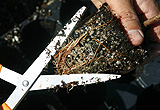
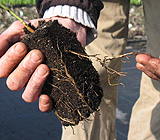 Mechanical root pruning can also be used on most tree and shrub species to eliminate most root defects. The pruning that seems to remove most defects peels off or shaves the entire outside surface of the root ball including the bottom (right photo). If roots are soft and young they can be pulled or teased away from the edge of the root ball and spread out into the substrate of the larger container or soil (left photo). This is time consuming and results can be variable. See: for larger trees.
Mechanical root pruning can also be used on most tree and shrub species to eliminate most root defects. The pruning that seems to remove most defects peels off or shaves the entire outside surface of the root ball including the bottom (right photo). If roots are soft and young they can be pulled or teased away from the edge of the root ball and spread out into the substrate of the larger container or soil (left photo). This is time consuming and results can be variable. See: for larger trees.

